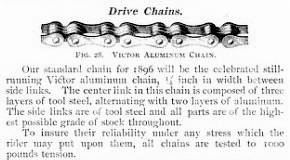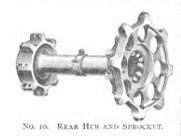

Commercial catalogs collection. Overman Wheel Co. Victor bicycles. 1896, University of Michigan.
Available online: http://hdl.handle.net/2027/mdp.39015071455961
Perhaps the perceived advantage was that each of the sprocket teeth could be much more substantial, but the trade-off of having half as many teeth makes this seem a wash and somehow the symmetry of the chains we use today seems more efficient (and in any event, that chain won out). Would this approach mean that the pins would bend less? (That may have been a problem in those days.) And maybe the relative cost of chains was more than today so a sturdier chain for the money seemed wise. Hard to know at this distance in time.
No comments:
Post a Comment